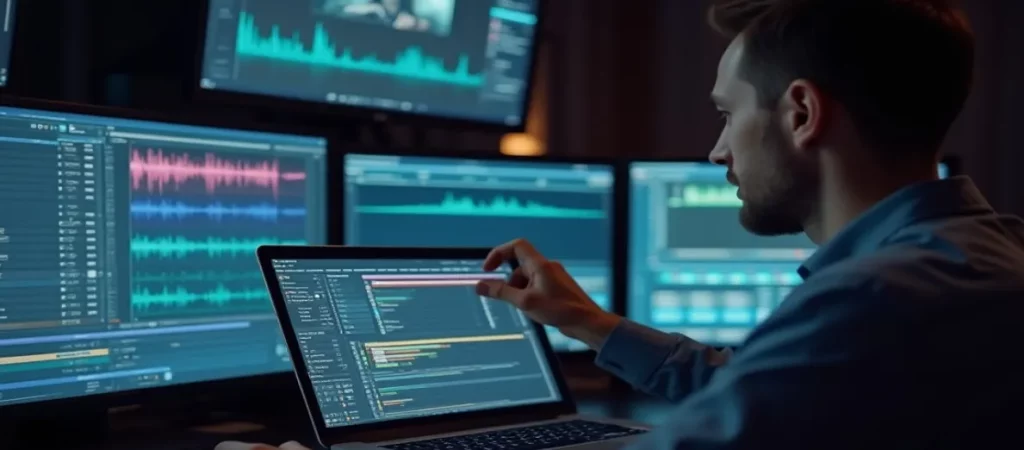Broadcast Monitoring Services boost your brand’s visibility, maintain compliance with broadcasting standards, and keep you informed on industry trends. Our digital age demands advanced, adaptable monitoring tools to stay ahead in a fast-paced media environment. Learn how these services work, why they are essential for your organization, and where broadcast monitoring is heading in the future.
Introduction to Broadcast Monitoring Services
The concept of broadcast monitoring goes beyond simply tracking what appears on television or radio. It involves systematically capturing, analyzing, and archiving media content from multiple channels, including satellite and cable TV, radio broadcasts, and even live streams. A well-rounded solution provides real-time insights and comprehensive archiving that help organizations make quick decisions and track message traction.
Definition and Scope of Broadcast Monitoring
Broadcast monitoring tracks audio and video content that airs on media platforms. It picks up mentions of brand names, products, spokespeople, or industry topics. It includes coverage on international news channels, local radio stations, and everything in between. The scope covers:
- News segments
- Commercial advertisements
- Live events
- Talk shows
- Documentary programs
These insights help teams evaluate a message’s impact or identify negative coverage. They also capture complete transcripts or audio clips so organizations can review them thoroughly.
Evolution and Significance in the Modern Media Landscape
Early broadcast monitoring required manual data gathering from newspapers and radio broadcasts. Organizations hired individuals to watch or listen all day and log mentions. That method was time-consuming and prone to missing key coverage. Today’s environment offers automated recording, speech-to-text software, and artificial intelligence tools that detect sentiment and track brand references.
These improvements have opened the door for real-time alerts and detailed analytics. People across public relations, marketing, and compliance use such data to adjust their strategies on the fly. Broadcast monitoring has evolved into an indispensable pillar of brand management, competitive intelligence, and quality control.
Importance of Broadcast Monitoring
Broadcast monitoring is vital in shaping how the public perceives brands, ensuring compliance with broadcasting laws, and keeping an eye on the competition. By staying proactive, companies can gain a competitive advantage and avoid misunderstandings that could derail their public image.
Role in Brand Reputation Management
Whether you are a multinational corporation or a local nonprofit, brand reputation matters. Broadcast monitoring identifies positive mentions that can be amplified through digital channels. It also helps teams spot negative coverage and mitigate potential fallout. With real-time monitoring, organizations can promptly respond to inquiries or inaccuracies, reducing the risk of lasting damage.
Ensuring Compliance With Broadcasting Standards
Broadcasting standards exist to protect viewers and listeners from inappropriate or misleading content. Regulatory bodies outline guidelines for language use, content type, and advertising. Failure to meet these requirements can lead to hefty fines or license revocations.
Broadcast monitoring solutions automate this compliance check. They flag questionable material, track political ad disclosures, or filter out content that violates decency regulations. This approach keeps stations and networks free from legal problems and preserves brand integrity.
Monitoring Competitors and Industry Trends
Staying informed about your peers in the marketplace is crucial. Monitoring competitor broadcasts sheds light on their messaging strategies, campaign focus, and market positioning. If a competitor gains traction from certain ads, you can adjust or counter those approaches. Similarly, keeping tabs on industry announcements and high-level trends allows teams to plan strategic marketing moves or see gaps that can be filled.
Leading the Way in Broadcast Monitoring
We at Digital Nirvana have always been passionate about delivering comprehensive broadcast monitoring solutions. Our approach focuses on advanced speech-to-text analytics, intuitive dashboards, and reliable archiving that serve organizations of every size. By emphasizing accuracy and real-time insights, we help clients spot brand mentions, track evolving narratives, and maintain a strong media presence without missing crucial details. Here’s more about us.
Key Features of Effective Broadcast Monitoring Tools
Organizations can only benefit from broadcast monitoring if their chosen tool offers thorough coverage, timely alerts, and robust analytics. Those features drive actionable insights and ensure that you receive a clear picture of your media presence.
Real-Time Monitoring Capabilities
Real-time monitoring keeps you informed the instant your brand appears on a broadcast. Automated systems capture and index content, giving you quick updates through email notifications or online dashboards. You do not have to wait for the next day’s recap to decide on your response.
Comprehensive Coverage Across Various Media Channels
Diversified media coverage is the norm. Radio, TV, streaming platforms, and podcasts all hold potential brand mentions. Effective monitoring tools integrate across these channels to ensure no coverage goes unnoticed. This coverage might include foreign-language broadcasts, which require translation support. By extending beyond local or national boundaries, organizations can spot global shifts in perception.
Advanced Analytics and Reporting Functionalities
Data in its raw form can be overwhelming. Advanced analytics present it in digestible metrics, charts, and graphs. Trend analyses show coverage spikes or dips, making it possible to track campaign performance. Sentiment analysis reveals whether mentions are positive, negative, or neutral, letting you respond appropriately. Customizable reporting helps stakeholders see what they need without searching through endless transcripts.
Benefits of Implementing Broadcast Monitoring Solutions
Broadcast monitoring solutions do more than capture mentions. They prevent crises, guide data-driven decisions, and streamline how you connect with your audience.
Proactive Crisis Management
Media crises can erupt at any moment, especially in industries where consumer trust is paramount. Broadcast monitoring alerts you to negative press or controversial segments as they happen. A rapid, measured response can minimize damage and highlight your commitment to addressing concerns. This agility often sets brands apart in high-stress situations.
Data-Driven Decision-Making
Executives who make decisions based on real-time data can pivot quickly. Broadcast monitoring provides quantifiable intelligence about public perception, competitor moves, and upcoming trends. Marketing teams can see the direct impact of TV commercials or brand ambassadors on public sentiment. Product managers can learn about recurring complaints or praises from talk shows or news reports.
Enhancing Audience Engagement Strategies
Viewing patterns have shifted. People watch TV on multiple devices, stream content at different times, and engage on social media. Broadcast monitoring data reveals which segments resonate with your target audience. That knowledge helps your organization create campaigns that feel more personal and valuable. You can use trending mentions or real-time feedback to keep your brand fresh and engaging.
Challenges in Broadcast Monitoring and Solutions
Broadcast monitoring can be complex, but strategic planning and reliable technology turn obstacles into opportunities. Below are some common hurdles and ways to tackle them.
Managing Vast Amounts of Data
Broadcasters generate enormous content daily. Large networks air 24-hour news cycles, and specialized channels produce niche programming. Sorting through such volumes can be daunting. Automated indexing, cloud-based storage, and machine-learning algorithms help you handle and categorize these vast libraries. This system ensures that your staff can search for specific topics without wading through thousands of irrelevant clips.
Ensuring Data Accuracy and Relevance
Speech-to-text and transcription software can have errors, especially with poor audio quality, strong accents, or overlapping voices. While technology continues to improve, a reliable broadcast monitoring service offers quality checks and error-correction mechanisms. Focus on solutions with high accuracy rates or editorial review features that maintain consistent data integrity.
Integrating With Existing Systems and Workflows
Organizations often use multiple platforms for media relations, marketing, and analytics. Tying broadcast monitoring into these systems can cause confusion if integration is not seamless. Opt for broadcast monitoring solutions that offer APIs or direct compatibility with popular software suites. That approach reduces duplication of efforts and promotes a unified data environment.
Top Broadcast Monitoring Service Providers
Organizations must evaluate leading providers in broadcast monitoring to determine which solution aligns best with their needs. Several vendors emphasize different strengths, such as global reach or real-time social media integration.
Overview of Leading Companies in the Industry
- Digital Nirvana: Delivers robust transcription accuracy, user-friendly dashboards, and real-time alerts that cater to stations and corporate brands.
- Critical Mention: Known for real-time television, radio, and online news monitoring.
- TVEyes: Renowned for advanced analytics and large coverage across international stations.
- Meltwater: Merges broadcast monitoring with social media listening for a more comprehensive view.
- Cision: Offers integrated PR and marketing solutions alongside robust broadcast tracking.
Comparison of Services and Features Offered
Organizations should consider:
- Coverage range: Is it global? Does it include regional channels?
- Accuracy: How advanced is their transcription or speech-to-text technology?
- Analytics and reporting: Do they offer customizable reports and easy data visualization?
- Integrations: Can the platform connect to CRM or marketing tools?
- Support and training: Do they have dedicated support teams or self-service portals?
Selecting the Right Broadcast Monitoring Service
Selecting a broadcast monitoring solution involves understanding your organization’s objectives, deciding how scalable the service needs to be, and balancing your budget with expected returns.
Assessing Organizational Needs and Objectives
Start by clarifying your goals. Are you focusing on brand reputation, advertising success, regulatory compliance, or competitor analysis? Some organizations may require multilingual support, while others need advanced analytics. You cannot choose the right solution if you do not have a clear picture of the scope and desired impact.
Evaluating Service Scalability and Flexibility
A startup’s requirements differ from those of a multinational corporation. Scalable monitoring tools let you add more channels, expand coverage areas, or handle higher volumes of incoming data as you grow. Ask about the flexibility to switch plans or increase capacity without incurring high costs.
Considering Budget Constraints and ROI
Broadcast monitoring platforms vary in cost based on coverage range and features. While some solutions require yearly commitments, others may offer monthly subscriptions or pay-per-use models. Determine how quickly you expect to see returns, whether through crisis prevention, improved customer sentiment, or refined marketing campaigns.
Case Studies: Successful Implementations
Real-world examples illustrate how organizations leverage broadcast monitoring to refine strategies and measure outcomes.
Examples of Organizations Benefiting From Broadcast Monitoring
- A global retail chain utilized broadcast monitoring to track local news reports in regions where it planned to open new stores. By analyzing sentiment, the company adapted public relations strategies and garnered stronger community support.
- A sports franchise employed broadcast monitoring during a major sports event to track real-time mentions of its athletes. Media coverage insights helped the team merchandise more effectively and launch well-received campaigns.
Lessons Learned and Best Practices
- Stay flexible: Media environments shift quickly, so update your monitoring parameters often.
- Combine data sources: Broadcast monitoring is more powerful when integrated with social media listening and print monitoring.
- Use clear reporting: Summaries and dashboards help decision-makers act fast and effectively.
Future Trends in Broadcast Monitoring
Broadcast monitoring is rapidly changing due to advances in artificial intelligence and the rise of social platforms. Keeping an eye on future trends means you can adopt innovative methods that optimize your efforts.
Impact of Artificial Intelligence and Machine Learning
AI-driven tools automatically categorize broadcasts, detect brand logos in video, and analyze sentiment. They also predict potential viral coverage by scanning for patterns in voice or text data. Machine learning refines these processes as more data is introduced. This leads to faster, more accurate detection of brand mentions, competitor activity, and changes in consumer perception.
Integration With Social Media Monitoring
Modern consumers often discuss broadcast segments on social media. A unified approach identifies coverage spikes and measures real-time reactions. Monitoring TV news about a product launch is less valuable if you do not connect it with social platform discussions. By melding broadcast and social analysis, organizations see how content resonates and react swiftly when sentiment shifts.
Predictions for the Evolution of Broadcast Monitoring
In the coming years, broadcast monitoring solutions will likely move toward fully automated clipping and summarizing. Tools will offer near-instant transcription that flags trending topics. Cloud-based services could become faster, and AI will handle more advanced tasks like providing strategic insights or identifying brand-safe vs. brand-unsafe environments. Broadcast monitoring will remain critical to any brand’s media intelligence strategy.
Integrating Broadcast Monitoring With Other Media Monitoring Tools
No media channel exists in a bubble. A mention on TV often spills over to digital media or print. Integrating broadcast, print, and online tools offers a more complete view of how coverage circulates.
Benefits of a Unified Media Monitoring Approach
When you unify broadcast monitoring with online, print, and social listening, you gain insights into each piece of coverage’s broader impact. A controversial TV segment might generate thousands of online comments or news articles. A single system that correlates all these mentions offers a clear timeline of how news develops and how you can respond.
Strategies for Seamless Integration
- Centralized dashboards: Pick tools that allow you to view multiple media streams in one interface.
- Common taxonomy: Define consistent keywords, categories, and tags across platforms.
- Automated alerts: Implement triggers that scan all media channels for keywords or sentiment changes.
Cost Considerations for Broadcast Monitoring Services
Organizations must look at pricing models and weigh them against the features they get. A budget-friendly service that sacrifices accuracy might lead to missed or misinterpreted coverage.
Understanding Pricing Models
- Subscription-based: Fixed monthly or yearly rate based on coverage volume, number of users, or analytics features.
- Pay-per-clip: You pay for each mention or each broadcast piece that’s captured.
- Hybrid approach: A base subscription plus a small per-clip fee for extra coverage or premium channels.
Balancing Cost With Feature Requirements
Evaluating ROI is essential. Some organizations find it cheaper to pay a little more for better coverage and advanced analytics because it can save them from reputational damage. Others might only need basic coverage to track mentions of a small brand or product line. Ask for free trials or demos to see if the solution meets your needs before locking into a contract.
User Training and Support in Broadcast Monitoring Solutions
An efficient platform is only as valuable as the people using it. Organizations should not overlook training and ongoing support when selecting a broadcast monitoring service.
Importance of Comprehensive Training Programs
Even user-friendly tools come with a learning curve. Training workshops, webinars, and onboarding sessions accelerate user adoption. Your staff can grasp report-building, dashboard customization, and alert management. A thorough training program ensures that you gain maximum value from your investment.
Evaluating the Quality of Customer Support
Reliable support teams are responsive, knowledgeable, and friendly. Check if the vendor offers 24/7 live support or if they rely on email-based help tickets. Evaluate how quickly they solve problems and whether they have a detailed knowledge base. High-quality support is crucial during crises when time-sensitive information might be at stake.
Measuring the ROI of Broadcast Monitoring Services
ROI is more than a simple cost-benefit statement. It is about how effectively the service drives tangible improvements in brand image, customer satisfaction, and revenue growth.
Key Performance Indicators to Track
- Volume of mentions: How often does your brand appear in broadcasts?
- Sentiment score: What is the tone of the coverage? Positive, negative, or neutral?
- Response time: How quickly can you react to breaking news or crises?
- Advertising effectiveness: Did broadcast mentions correlate with sales or inquiries?
Demonstrating Value to Stakeholders
Show marketing executives how real-time alerts helped tweak campaigns. Present case studies where negative coverage was identified and addressed before it blew up. Demonstrate improvements in brand perception or share of voice. Quantifying these metrics helps justify the expense and highlight the necessity of broadcast monitoring in brand stewardship.
Legal and Ethical Considerations in Broadcast Monitoring
Broadcast monitoring involves capturing and storing content from various sources. That raises questions about intellectual property and ethics.
Understanding Copyright Laws and Regulations
Broadcast content is often protected by copyright. Monitoring solutions store it for analysis, but not for public distribution. Ensure that the service you use has the proper licenses or adheres to fair use guidelines. Using licensed content outside the platform’s intended scope could lead to legal complications.
Ensuring Ethical Monitoring Practices
Consumers expect privacy, even in public broadcast channels. While broadcast content is public, organizations still have a responsibility to maintain data responsibly. Ensure that you do not misuse personal data or misrepresent broadcast segments. Being transparent in how you collect and use the data can safeguard your reputation and stay within ethical boundaries.
Technical Requirements for Implementing Broadcast Monitoring
Effective broadcast monitoring also depends on the infrastructure you have in place.
Necessary Infrastructure and Tools
- High-speed internet: Essential for continuous streaming and data transfers.
- Storage: Cloud-based solutions reduce the burden of local servers.
- Compatible hardware: Some broadcast monitoring services may require specific encoders or recording hardware.
Addressing Potential Technical Challenges
System crashes or internet outages can cause data gaps. Platforms that offer redundancy or automatic failover protect you from losing vital coverage. Regular maintenance and software updates reduce downtime and ensure that your monitoring system remains optimal.
Customizing Broadcast Monitoring for Different Industries
Media needs differ by industry. Broadcasters, PR agencies, government organizations, and healthcare companies each have unique considerations.
Tailoring Solutions to Specific Industry Needs
- Healthcare: Focuses heavily on regulatory compliance when ads appear.
- Financial services: Tracks coverage around quarterly earnings and stock performance.
- Government agencies: Often rely on broadcast monitoring to address public concerns quickly.
Industry-Specific Challenges and Considerations
Security is a priority for government agencies. Healthcare advertisers need to make sure they do not violate guidelines on medical claims. Financial announcements often call for immediate response to manage investor sentiment. Custom solutions address these nuances.
Impact of AI and Machine Learning on Broadcast Monitoring
AI and machine learning technologies are revolutionizing how monitoring services operate, from speech recognition to advanced forecasting.
Enhancing Data Analysis and Pattern Recognition
Machine learning algorithms can cross-reference news segments with stock market movements or spot repeated phrases that signify a growing trend. Pattern recognition in large sets of broadcasts can highlight issues that might otherwise remain unnoticed.
Automating Routine Monitoring Tasks
AI-powered solutions automatically scan content for certain topics or brand mentions, then send alerts. They can also generate summaries, saving time for analysts who need a quick overview. By eliminating many manual tasks, teams can focus on interpreting data and creating action plans.
Real-Time vs. Archived Broadcast Monitoring
Companies sometimes need immediate access to broadcasts, while others might rely on historical data for in-depth analysis.
Benefits and Limitations of Each Approach
- Real-time: You catch breaking news, brand mentions, and crises as they unfold. However, it may come with higher costs due to continuous streaming and quick processing.
- Archived: You can research historical coverage patterns, but you will not get immediate notifications. This approach is cost-effective and beneficial for trend analysis over extended periods.
Determining the Best Fit for Organizational Needs
An ad agency launching a product might lean on real-time coverage to measure campaign effectiveness by the hour. A research institute analyzing long-term trends would find archived coverage more relevant. Some organizations opt for a hybrid approach, combining real-time alerts for urgent matters with archival tools for extended analyses.
Understanding Broadcast Monitoring Analytics and Reporting
Raw data loses value if you cannot interpret it. Analytics and reporting tools transform thousands of broadcast hours into actionable insights.
Key Metrics to Monitor
- Share of voice: Compares your brand mentions to competitor mentions.
- Topic frequency: Tracks how often a particular issue appears in coverage.
- Time of day: Measures when mentions spike. This can inform the best times to release statements or updates.
- Geographic distribution: Identifies which regions talk about your brand the most.
Utilizing Reports for Strategic Planning
Reports are roadmaps that guide brand strategy, public relations, and even product development. Marketing teams might adjust messaging or placement. Executives could allocate resources to regions with the highest media traction. Broadcasting stations could refine their programs if they see an opportunity to draw more viewers.
Common Pitfalls to Avoid in Broadcast Monitoring
Even the most advanced solution can fall short if it is not set up or maintained correctly. Certain oversights often undermine a broadcast monitoring strategy.
Overlooking Data Privacy Concerns
Broadcast content is public, but storing and using it must still comply with privacy guidelines. Some broadcasts may include personal data or sensitive topics that need safeguarding. Work only with vendors who prioritize encryption and respect local regulations.
Neglecting to Update Monitoring Parameters Regularly
Media landscapes shift quickly. If you do not update your keywords, channels, or brand references regularly, you risk missing relevant coverage. A newly launched product might not be monitored if you forget to add it as a keyword. Maintaining an up-to-date monitoring framework maximizes accuracy and relevance.
Conclusion
Broadcast Monitoring Services offer near-instant insights into how your brand appears in TV, radio, and streaming broadcasts. They protect your reputation, facilitate compliance, and reveal important trends in your industry. The future of broadcast monitoring involves deeper integration with AI, social media analytics, and real-time reporting.
We encourage you to explore the possibilities that broadcast monitoring can create for brand management, regulatory assurance, and informed decision-making. Take these strategies, tailor them to your organization’s priorities, and see how your media presence transforms. Start building a robust broadcast monitoring plan that puts you in control.
Digital Nirvana: Empowering Knowledge Through Technology
Digital Nirvana stands at the forefront of the digital age, offering cutting-edge knowledge management solutions and business process automation.
Key Highlights of Digital Nirvana –
- Knowledge Management Solutions: Tailored to enhance organizational efficiency and insight discovery.
- Business Process Automation: Streamline operations with our sophisticated automation tools.
- AI-Based Workflows: Leverage the power of AI to optimize content creation and data analysis.
- Machine Learning & NLP: Our algorithms improve workflows and processes through continuous learning.
- Global Reliability: Trusted worldwide for improving scale, ensuring compliance, and reducing costs.
Book a free demo to scale up your content moderation, metadata, and indexing strategy, and get a firsthand experience of Digital Nirvana’s services.
FAQs
- Are broadcast monitoring solutions only useful for large corporations?
They benefit organizations of all sizes. Smaller businesses can track regional media, while bigger brands require global coverage. - How accurate are automated transcriptions in broadcast monitoring?
Advanced speech-to-text engines are quite accurate, often exceeding 90%. Many platforms also provide editing tools or manual review options. - Can broadcast monitoring services also track social media mentions in real time?
Some do. Others integrate with specialized social media monitoring tools. This unified approach provides a complete picture of brand coverage. - Do I need technical expertise to implement a broadcast monitoring tool?
Most vendors handle setup and configuration. While some technical knowledge can help, they typically offer full support and training. - Is it possible to measure ROI for broadcast monitoring solutions? Yes. Metrics like sentiment scores, response times, and share of voice quantify how monitoring impacts brand performance and sales.




